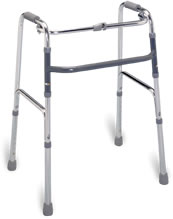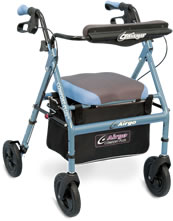
| Walker Facts |
Which walker is right for me?
The Final Choice: Walker or Rollator
The final choice of walker is usually based on a series of compromises defined by your physical status, the different places you walk, the activities in which you participate, availability of assistance or supervision if needed, and your budget.
If there is any question as to which walker is the right choice for you, it is best to seek assistance from a certified therapist, such as a physical or occupational therapist. In addition to helping with the selection of the walker, your therapist can consider future physical changes, arrange for trial equipment, train you to use the walker safely, and may assist with funding that is available in your area.
Do I need a therapist to buy a walker?
Summary:
Differences between stable walkers and rollators
Stable Walkers – no wheels |
|
Accessories commonly available:
|
|
Maneuverable Rollator – four wheels |
|
Accessories commonly available:
|
|
Choosing the Right Walker
You’ll need to consider much more than physical ability.
What about the environment and social supports?
Do You Need a Therapist?
And if so, how do you find a therapist?
We have a number of associations you may contact.
Where to Purchase a Walker
You have options and we have recommendations.
There is also financial assistance available to you.
Using a Walker Safely
From basic activities to common mistakes, here’s a guide to help you use your non-wheeled walker or wheeled walker safely and effectively.
Frequently Asked Questions
Commonly given answers. Feel free to contact us if you’d like to contribute and help others.
Case Studies
Professionally prepared resources that offer guidance to a successful thought process based on past experiences.
Sponsors
Many thanks to these companies for sponsoring Walker Facts. It's their support that keeps this resource free to everyone.







